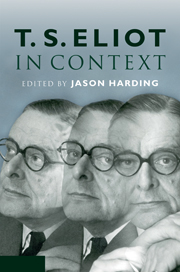Book contents
- Frontmatter
- Contents
- List of illustrations
- List of contributors
- Acknowledgements
- List of abbreviations
- Introduction
- PART ONE LIFE
- PART TWO FORMS
- PART THREE LITERARY CROSS-CURRENTS
- 16 Allusion: the case of Shakespeare
- 17 Classics
- 18 Dante
- 19 Seventeenth-century literature
- 20 Romantic and Victorian poetry
- 21 French poetry
- 22 Georgian poetry
- 23 Bloomsbury
- 24 Ezra Pound
- 25 The avant-garde
- PART FOUR POLITICS, SOCIETY AND CULTURE
- PART FIVE RECEPTION
- Further reading
- Index
24 - Ezra Pound
Published online by Cambridge University Press: 05 August 2012
- Frontmatter
- Contents
- List of illustrations
- List of contributors
- Acknowledgements
- List of abbreviations
- Introduction
- PART ONE LIFE
- PART TWO FORMS
- PART THREE LITERARY CROSS-CURRENTS
- 16 Allusion: the case of Shakespeare
- 17 Classics
- 18 Dante
- 19 Seventeenth-century literature
- 20 Romantic and Victorian poetry
- 21 French poetry
- 22 Georgian poetry
- 23 Bloomsbury
- 24 Ezra Pound
- 25 The avant-garde
- PART FOUR POLITICS, SOCIETY AND CULTURE
- PART FIVE RECEPTION
- Further reading
- Index
Summary
In ‘Desolation Row’ Bob Dylan sings:
And everybody's shouting
‘Which Side Are You On?’
And Ezra Pound and T. S. Eliot
Fighting in the captain's tower
While calypso singers laugh at them
And fisherman hold flowers
Between the windows of the sea
Where lovely mermaids flow
And nobody has to think too much
About Desolation Row
Ezra Pound and T. S. Eliot turn up in a line where ‘and’ is sent in two syntactical directions: ‘And Ezra Pound and T. S. Eliot’. Eliot's early poem ‘Opera’ begins with ‘Tristan and Isolde / And the fatalistic horns’ (IMH, 17), swerving from fusing two selves to point out structural distinctions. In Dylan's song the first ‘and’ spotlights how the next conjunction works differently, linking Pound and Eliot in an intimately antagonistic double act. The tuneful pairing of their names, like Bonnie and Clyde, Laurel and Hardy, Tristan and Isolde, might prompt us to wonder about the nature of the ‘and’ in pairs so famous, seeming to join two persons, elusively, as one. Our habituation to the cadences of pairing (after all, why not Clyde and Bonnie or Cleopatra and Antony?), registers how we become culturally accustomed to the sound of a composite identity, hailing from two persons but not exactly belonging to either of them.
- Type
- Chapter
- Information
- T. S. Eliot in Context , pp. 241 - 251Publisher: Cambridge University PressPrint publication year: 2011

